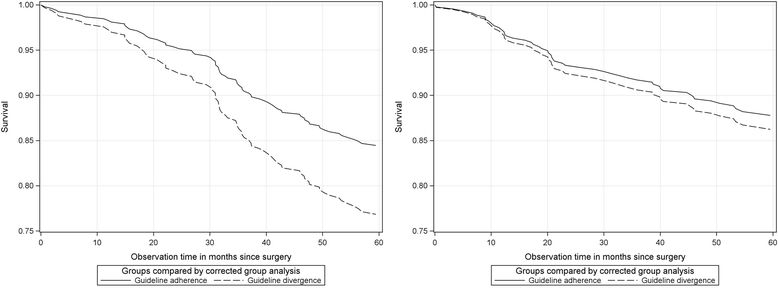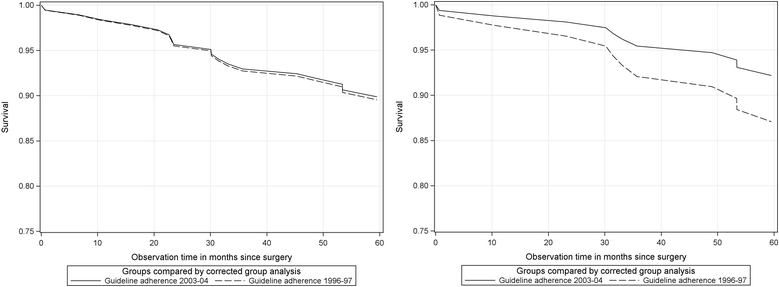The adherence paradox: guideline deviations contribute to the increased 5-year survival of breast cancer patients
- PMID: 26481452
- PMCID: PMC4612495
- DOI: 10.1186/s12885-015-1765-0
The adherence paradox: guideline deviations contribute to the increased 5-year survival of breast cancer patients
Abstract
Background: In German breast cancer care, the S1-guidelines of the 1990s were substituted by national S3-guidelines in 2003. The application of guidelines became mandatory for certified breast cancer centers. The aim of the study was to assess guideline adherence according to time intervals and its impact on survival.
Methods: Women with primary breast cancer treated in three rural hospitals of one German geographical district were included. A cohort study design encompassed women from 1996-97 (N = 389) and from 2003-04 (N = 488). Quality indicators were defined along inpatient therapy sequences for each time interval and distinguished as guideline-adherent and guideline-divergent medical decisions. Based on all of the quality indicators, a binary overall adherence index was defined and served as a group indicator in multivariate Cox-regression models. A corrected group analysis estimated adjusted 5-year survival curves.
Results: From a total of 877 patients, 743 (85 %) and 504 (58 %) were included to assess 104 developed quality indicators and the resuming binary overall adherence index. The latter significantly increased from 13-15 % (1996-97) up to 33-35 % (2003-04). Within each time interval, no significant survival differences of guideline-adherent and -divergent treated patients were detected. Across time intervals and within the group of guideline-adherent treated patients only, survival increased but did not significantly differ between time intervals. Across time intervals and within the group of guideline-divergent treated patients only, survival increased and significantly differed between time intervals.
Conclusions: Infrastructural efforts contributed to the increase of process quality of the examined certified breast cancer center. Paradoxically, a systematic impact on 5-year survival has been observed for patients treated divergently from the guideline recommendations. This is an indicator for the appropriate application of guidelines. A maximization of guideline-based decisions instead of the ubiquitous demand of guideline adherence maximization is advocated.
Figures




Similar articles
-
Adherence to breast cancer guidelines is associated with better survival outcomes: a systematic review and meta-analysis of observational studies in EU countries.BMC Health Serv Res. 2020 Oct 7;20(1):920. doi: 10.1186/s12913-020-05753-x. BMC Health Serv Res. 2020. PMID: 33028324 Free PMC article.
-
[Effects of guideline-compliant therapy on the survival of primary breast cancer patients with: results of a retrospective cohort study].Z Evid Fortbild Qual Gesundhwes. 2011;105(6):468-75. doi: 10.1016/j.zefq.2011.03.007. Epub 2011 Apr 7. Z Evid Fortbild Qual Gesundhwes. 2011. PMID: 21843852 German.
-
Comorbidity-dependent adherence to guidelines and survival in breast cancer-Is there a role for guideline adherence in comorbid breast cancer patients? A retrospective cohort study with 2137 patients.Breast J. 2018 Mar;24(2):120-127. doi: 10.1111/tbj.12855. Epub 2017 Jul 7. Breast J. 2018. PMID: 28685896
-
Triple-negative breast cancer: the impact of guideline-adherent adjuvant treatment on survival--a retrospective multi-centre cohort study.Breast Cancer Res Treat. 2012 Apr;132(3):1073-80. doi: 10.1007/s10549-011-1935-y. Epub 2011 Dec 29. Breast Cancer Res Treat. 2012. PMID: 22205141
-
Adherence to quality indicators and survival in patients with breast cancer.Med Care. 2009 Feb;47(2):217-25. doi: 10.1097/MLR.0b013e3181893c4a. Med Care. 2009. PMID: 19169123
Cited by
-
A Pragmatic Benchmarking Study of an Evidence-Based Personalised Approach in 1938 Adolescents with High-Risk Idiopathic Scoliosis.J Clin Med. 2021 Oct 28;10(21):5020. doi: 10.3390/jcm10215020. J Clin Med. 2021. PMID: 34768544 Free PMC article.
-
Providers and Patients Caught Between Standardization and Individualization: Individualized Standardization as a Solution Comment on "(Re) Making the Procrustean Bed? Standardization and Customization as Competing Logics in Healthcare".Int J Health Policy Manag. 2018 Apr 1;7(4):349-352. doi: 10.15171/ijhpm.2017.95. Int J Health Policy Manag. 2018. PMID: 29626403 Free PMC article.
-
Adherence to breast cancer guidelines is associated with better survival outcomes: a systematic review and meta-analysis of observational studies in EU countries.BMC Health Serv Res. 2020 Oct 7;20(1):920. doi: 10.1186/s12913-020-05753-x. BMC Health Serv Res. 2020. PMID: 33028324 Free PMC article.
-
Role of patient characteristics in adherence to first-line treatment guidelines in breast, lung and prostate cancer: insights from the Nordic healthcare system.BMJ Open. 2024 Apr 8;14(4):e084689. doi: 10.1136/bmjopen-2024-084689. BMJ Open. 2024. PMID: 38589254 Free PMC article.
-
Individualized Care Is Superior to Standardized Care for the Majority of Critically Ill Patients.Crit Care Med. 2020 Dec;48(12):1845-1847. doi: 10.1097/CCM.0000000000004373. Crit Care Med. 2020. PMID: 32332282 Free PMC article.
References
-
- Robert Koch-Institut. Krebs in Deutschland 2009/2010. Gesundheitsberichterstattung des Bundes. Berlin; 2013.
-
- Globocan database: estimated cancer incidence, mortality, prevalence and disability-adjusted life years (DALYs) worldwide in 2008. http://globocan.iarc.fr/ Accessed 14 Jun 2014.
-
- Globocan database: estimated cancer incidence, mortality, and prevalence worldwide in 2012. http://globocan.iarc.fr/ Accessed 18 Jul 2014
Publication types
MeSH terms
LinkOut - more resources
Full Text Sources
Other Literature Sources
Medical

